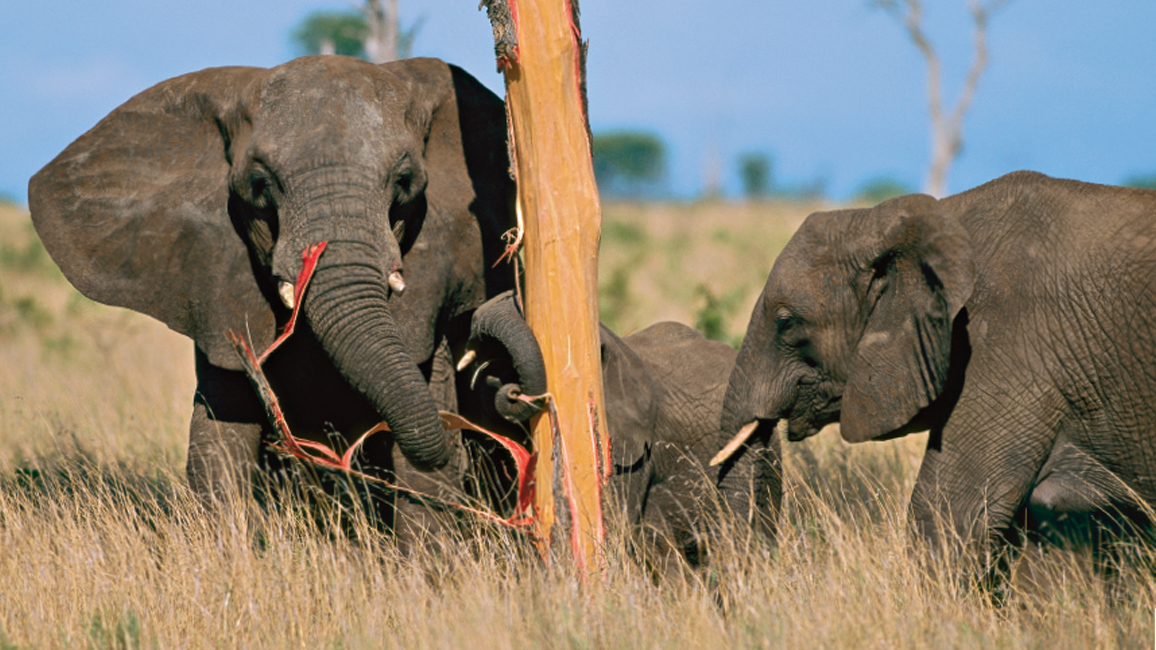
Bark
By Gerry Bishop“Ahhhhh, I just LOVE bark!” That’s what this back-scratching bear might be thinking. And by the time you finish reading this story, YOU might be thinking it, too!
A tree with rough bark can make a great scratching post for a bear. But bark has more important jobs to do than that. For a tree, bark is like a layer of tough skin or a suit of armor. It helps protect the tree from diseases, hungry insects, bumps and bruises, and even fire.
Bark can be important to people, too. Since ancient times, we’ve used chemicals in bark to turn animal skins into leather. We’ve used birch bark to build canoes and willow bark to make aspirin. And we get both cork and cinnamon from bark.
Wait—There’s More!
There are many other reasons to appreciate bark. Just look at some of the different colors and patterns shown at left. Beautiful, don’t you think?
Touch different kinds of bark and you’ll feel roughness, smoothness, hardness, or even softness. Scratch and sniff some and you might get a pleasant surprise. (Ponderosa pine bark smells like vanilla!)
Bark Lovers, Everywhere
Bears and people aren’t the only animals that use and love bark. Some animals eat it, hide in it, or even build with it!
ANIMALS & BARK
BARK SHIELD
This black-throated green warbler has made the most of a peeling piece of birch bark. She and her mate built the nest behind it, and now she sits quietly on her eggs. The bark supports the nest and hides her well.
SNACK STRIPS
Bark makes a great meal for African elephants. First an elephant jabs a tusk into the side of a tree and loosens a big piece. Using its trunk, the elephant then r-r-rips the loose bark from the tree and stuffs it in its mouth. Huge teeth and powerful jaws grind the bark into mush, and down the hatch it goes.
WINTER HOME
Every fall, all over the American West, convergent ladybird beetles get the same message: Winter’s coming! It’s time to head for cover!
Masses of beetles begin converging, or coming together, in places where they can hibernate through the coldest months. (The ones shown here have found a cozy crack in a tree’s bark.) Then, in spring, the beetles scatter far and wide to gobble up aphids and other insects.
DAYTIME HIDEOUT
At night, gray treefrogs hop about, looking for food or mates. But during the day, they head for places to hide and sleep. This one has found a cozy place under a piece of tree bark that matches its color. Hungry birds or snakes will need good luck to find it now!
RUGGED LADDER
This mountain kingsnake is climbing straight up a tree. How does it hold on? Mostly with its belly scales.
Each belly scale is a bit like a fingernail that can grab on to the bark’s rough surface. The snake also bends parts of its body into cracks in the bark. Then, while holding on tight, the snake pushes and pulls itself upward.
The climbing is hard work. But good things to eat—such as a nest full of bird eggs—could be waiting high above.
SAVINGS BANK
The acorn woodpecker at right is part of a flock that has pecked holes in the thick bark of a tree. And now he’s getting ready to fit an acorn into one. Why? The birds are using the bark as a savings bank! When they’re done, the tree may have up to 50,000 acorns stored in it. And the birds can make tasty “withdrawals” all season long.
SAP TAP
The bark on this paper birch tree wasn’t tough enough to keep a yellow-bellied sapsucker from pecking holes to reach the tree’s sweet sap. And now a ruby-throated hummingbird, which can’t make holes, has come to sip the sap that’s still leaking out.
Rangers:
How many different kinds of bark are in your neighborhood? Are any animals using it? Go outside and see!
—R.R.
“Bark” originally appeared in the March 2016 issue of Ranger Rick magazine.
(Click on each image above for a closer view of the story.)



















